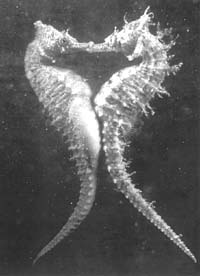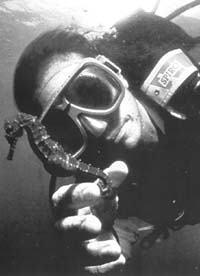Conversation biology: A difficult balancing act
by Shaun Goho
 |
Professor Amanda Vincent on dry land and (bottom) underwater with the subject of her studies
[ PHOTO: OWEN EGAN ]


|
When you're sitting in a crowded boardroom, hammering out the details of an international agreement, it might seem a long way from scuba diving in search of seahorses off the coast of Australia. But as Amanda Vincent sees it, they are both just parts of her job.
Vincent is an assistant professor of biology at McGill and an ardent conservationist. Her ticket into the world of conservation, and the focus of her management efforts and research, has been the seahorse. Comprising roughly 35 species of the genus Hippocampus, these little-known but appealing creatures range in size from a couple of centimetres to a third of a metre. Despite their name, they are in fact fish, though a highly derived and unusual group, with their horse-like snouts and prehensile tails.
The abnormalities do not end with their appearance. Vincent was inspired to begin research on seahorses by some of their behavioural peculiarities. Not least of these is the fact that, in seahorses, it is the male who gets pregnant.
"It is an extreme example of male care," explains Vincent. "It's probably the most extreme example known, in that the male not only protects the young and fertilizes them in his pouch, but also aerates and controls the pouch environment and provides nutrition."
Vincent's research is providing new insights into the variety and nature of sex roles in animals. In addition, an increased understanding of the biology of seahorses--and Vincent is recognized as a world expert--is essential to their preservation.
"Seahorses turn out to represent a whole new genre of fisheries which are being exploited," she says. According to Vincent, they are sold as ingredients for traditional Chinese medicine, as aquarium pets and as curios. She estimates that the medicinal trade alone consumes at least 20 million dried seahorses per year. Virtually all seahorse species are now on the IUCN (International Union for the Conservation of Nature) Red List as "vulnerable," one category below "endangered."
However, there are no simple solutions. Seahorses do not live in the open sea. They are not fished by trawlers with drag nets. Instead, they live in seagrass beds, in mangrove swamps and on coral reefs. They are fished by poor, subsistence fishers who derive much of their income from seahorses. And they are valuable: Vincent reports that one kilogram of dried seahorses can fetch up to $1200 U.S. in the markets of Hong Kong.
Therefore, Vincent and her collaborators have had to be innovative in their conservation and management efforts. Through an initiative called Project Seahorse, they are coordinating activities ranging from investigating the scope of the trade to raising awareness in the west, to working with the fishers themselves.
One pilot project is taking place in Handumon, a small village in the Philippines. "We now have a community-based project," explains Vincent, "where we impose nothing, we promise nothing--but good things happen nonetheless."
The villagers have set up a "marine protected area," where no fishing is allowed. As well, when pregnant males are caught, they are now left in cages in the sea until the young are released. Captured juveniles are left in corrals to allow them to grow and reproduce before they are harvested.
Though seahorses are the main focus of her efforts, Vincent says she is "using seahorses as a tool for rather bigger issues." Most conservation efforts are directed at the preservation of individual species, even though the loss of habitat is the greatest threat to wildlife in the world today. However, Vincent believes that even the conservation of a single species can serve the larger purpose of habitat protection: to save a species, you must also save its habitat.
In the case of the seahorse, its habitats include some of the most threatened, yet most ignored, in the world.
"When you are dealing with seagrass beds, for example," she explains, "they're the squidgy bits between your toes to most people. But if you stick a seahorse in there, suddenly they become important in terms of conservation."
Even while pursuing her research, Vincent makes no effort to disguise the fact that she is also an activist. "I see absolutely no conflict between my academic role and my advocacy role," she says. "In fact, I see them as complementary."
This combination is central to her view of the field of conservation biology as a whole. "If you call yourself a conservation biologist," she says, "then for the most part you have an obligation to be active in conservation, and conservation is not achieved in learned journals, although very important seeds can be planted there. I am exasperated by most academics, who don't see themselves as having a role in the bigger world."
One aspect of the advocacy role with which many scientists are uncomfortable is the need for policy decisions to be made before scientific certainty is achieved. Vincent is adamant on this point.
"If in conservation we insist on having complete knowledge," she says, "we will lose everything."
By pressing for action now with seahorses, Vincent has seen them placed on the European Community's Annex D, "which will mean that any import to or export from the EC must be monitored, recorded and reported.
"If we had not taken action with incomplete knowledge," she concludes, "we would not be getting the monitoring that will be coming out of the EC, which will give us more complete knowledge, on which we can take more decisive action.
"What conservation biologists have to learn to do is to act on incomplete knowledge, and be open about the fact it's incomplete, such that they maintain their intellectual integrity but also provoke action. And I think that's a really difficult balancing act."
A documentary called "Kingdom of the Seahorse" based on the work of Professor Vincent will be aired on the PBS program NOVA, on Vermont ETV, Tuesday, April 15 at 8 pm and on Mountain Lake Television, Thursday, April 17 at 9 pm.